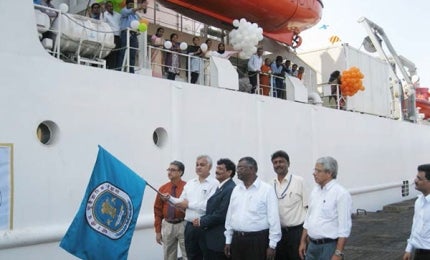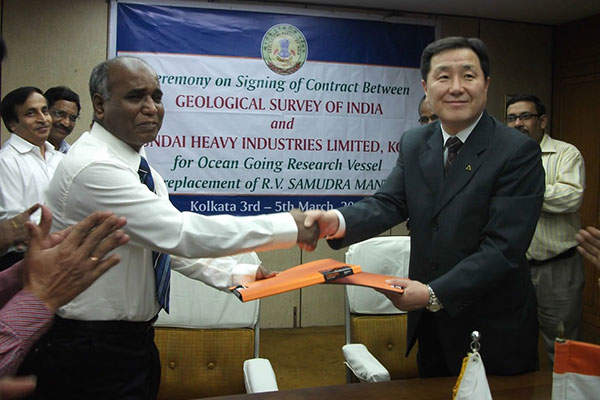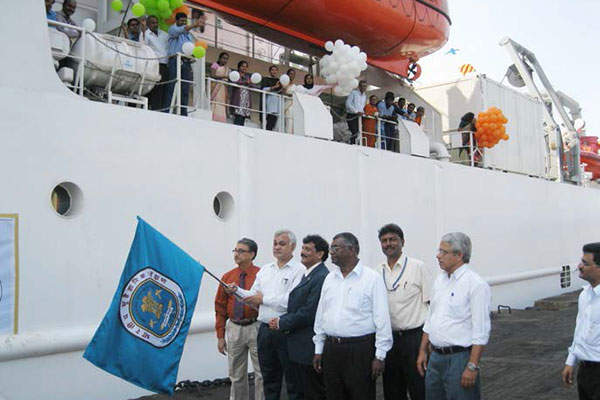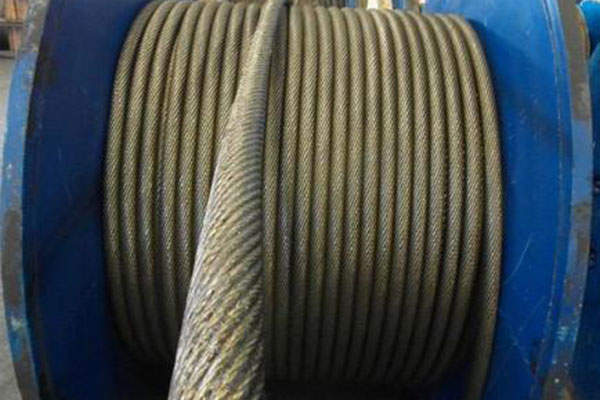
RV Samudra Ratnakar is a new oceanographic research vessel built by Hyundai Heavy Industries (HHI) at its Ulsan shipyard in South Korea. The vessel was built at an estimated cost of INR5.49bn (approximately $100.4m), for its owner Geological Survey of India (GSI). First steel for the vessel was cut in March 2012 and delivery took place in September 2013.
The research vessel was dedicated to the nation in a ceremony held at Kandla Port in October 2013. It then underwent successful sea trials and GSI geoscientists were trained by the OEM in the operation and maintenance of the various scientific equipment onboard.
RV Samudra Ratnakar is fitted to perform sea-bed mapping, deep-water mineral exploration and geoscientific explorations, such as multi-channel seismic survey, gravity survey, magnetic survey, deep sea imaging, sub-bottom profiling, deep coring and dredging within the Exclusive Economic Zone (EEZ) of India, as well as international waters.
In 2013, the vessel’s maiden scientific cruise in the Arabian Sea formed part of the National Programme on High-Resolution Seabed Mapping and Natural Resource Evaluation (NHRSM & NRE).
GSI plans to organise 215 cruises of 45 days each by partnering with other government organisations, such as National Institute of Oceanography, Oil and Natural Gas Commission (ONGC), National Institute of Ocean Technology (NIOT) and National Centre for Antarctic and Offshore Research (NCAOR), for survey of the full ocean depth to approximately 10,000m.
RV Samudra Ratnakar design and features
GSI contracted the Shipping Corporation of India (SCI) and Wartsila Ship Design Norway (WSDN) for the design of the vessel.
The 103.4m-long vessel has a moulded breadth of 19.2m and deadweight of approximately 2,700t at maximum draught of 6m. The gross and net tonnage capacities of the vessel are 6,551t and 1,965t respectively. The vessel can cruise at a maximum speed of 14k for 45 days continuously.
RV Samudra Ratnakar has been assigned dual class notation by Det Norske Veritas (DNV) and Indian Register of Shipping (IRS). She is classified as 1A1 COMF-V (3) C (3) E0 DYNPOS-AUT NAUT-AW DK (+).
She features a differential global positioning system (DGPS) fitted for working in all-weather conditions, to provide stability to the vessel while carrying out deep-sea explorations. The vessel can provide accommodation to 73 people, including 25 geoscientists.
Scientific equipment onboard the research vessel
RV Samudra Ratnakar is fitted with highly advanced equipment, including deep-water and shallow-water multi-beam survey systems, a sub-bottom profiling system to map the marine sediment layers, a single-streamer multi-channel seismic system (960 channels, 6km streamer), an acoustic doppler current profiler (ADCP) to measure water current velocities and an acoustic positioning system (APS).
The new Norwegian marine research vessel RV Dr Fridtjof Nansen is owned by the Norwegian Agency for Development Cooperation (NORAD).
The vessel features onboard laboratories fitted with advanced acoustic equipment, which allows scientists to map the deepest layer of the oceans and carry out mineral explorations and other oceanographic research.
Multi-disciplinary scientific equipment onboard the vessel includes a single-beam echo sounder, side scan sonar, marine magnetometer and gradiometer, marine gravimeter, heat-flow measuring system, current meter, conductivity-temperature-depth (CTD) system, synthetic aperture sonar (SAS) system and underwater camera.
The vessel is equipped with a seismic research system for investigating crustal structure. Sampling devices include piston corer with maximum penetration of approximately 30m, vibrocorer with penetration ranging from eight metres to ten metres, spade corer, dredger, grabs, core slitter, core cutter and a remotely operated vehicle (ROV) system. An X-Ray core scanner and water sampler for collecting seawater at various depths are also provided.
Contractors and suppliers for the vessel
Caley Ocean Systems was contracted by HHI to supply oceanographic winches and A-frame systems for the new research vessel.
Lankhorst supplied one 6x36WS+IWRC and two LANKOPACK steel wire ropes for the oceanographic research vessel. A 30mm LANKOPACK was used as a traction winch and another of 16mm as an auxiliary winch drum.
Kongsberg GeoAcoustics supplied a full side-scan sonar package to HHI in January 2013. The 30m giant piston corner was supplied by UK-based Ocean Scientific International (OSIL).






